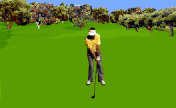A recent article PGA standout Sergio Garcia stressed the importance of hitting good wedge shots. We couldn’t agree more with Sergio. Good wedge play is the foundation of a solid short game. A good wedge shot—whether hit with a pitching, sand, lob, or flop wedge—can turn three shots into two and bogies into pars. Over the course of a round, good wedge play can mean the difference between breaking 100, 90, or even 80. If you’re serious about shaving strokes off your golf handicap, master your wedges.
Below are five keys to help you hit solid wedges consistently.
CB Advertisement
Set-Up Correctly
Not all bad shots stem from bad swings. Sometimes, they’re the result of not setting up correctly. That’s why in individual golf lessons we emphasize setting up properly for all shots, not just wedge shots. The keys to setting up correctly for wedge shots are to bend natural from the hips, keep the knees flexed slightly, use a one piece takeaway, position the ball back in your stance, and employ a three-quarter swing to better control the shot. More importantly, use a slightly open stance. It helps you clear the left side (right side, if you’re left-handed) in the downswing. Setting up properly delivers the clubface back to the ball on an ideal path and angle of attack.
Smooth and Simple
You must keep your swing smooth and simple when hitting wedges. Wedges aren’t woods. You don’t need a lot of power to hit them. You also don’t need a lot of lower body action. You can hit solid wedges with a minimum of effort. When you hit wedge shots, you should almost feel flat-footed. They require so little effort to hit you should be able to hit a bucket of balls without tiring. Simply turn through the ball.

Open The Face
If our golf lessons we see a lot of weekend players close the clubface during their takeaways. Holding the clubface closed as you go back is fatal. It kills you’re rhythm and stops you from rotating the clubface naturally. If you don’t allow the natural rotation of your forearms both back and through your swing, you can’t stay connected during the swing or accelerate through impact. Opening the clubface during the takeaway creates a smooth accelerating release that produces clean, crisp contact.
Natural Rotation
You must avoid a forced rotation of your forearms when taking the club back. Let it happen naturally. It’s easy to see in golf instruction sessions how some students confuse opening the clubface with twisting the wrists, which whips the clubhead behind you. It’s not the same. Opening the clubface is more natural than twisting. So let it happen. The feeling you’re after is a gently rolling of your forearms. You’ll know you’re doing it correctly, if the top of your club points out in front of you when you complete your swing, not toward the sky.
Knuckles Down
Ball position with wedges is toward the center. This back ball position is where the bottom of your natural wedge swing occurs in front of the ball. It’s what allows you to hit down on the ball, but only if you maintain a descending swing path. To make sure this happens, focus on keeping the left-hand knuckles (right-hand knuckles, if you’re left handed) pointing toward the ground. If they point up, you have no chance of making crisp contact.
Wedges are key scoring clubs. They’re invaluable when you need to hit it close after missing the green with an approach shot. The five keys discussed above—along with the accompanying golf tips—will help you hit clean, crisp, accurate wedges. If you’re serious about shaving strokes off your golf handicap, master your wedges. They can help you turn three shots into two, as we often said in our golf tips newsletter, and bogies or double bogies into pars.
This entry was posted on Monday, September 20th, 2010 at 1:08 pm and is filed under Golf Articles. You can follow any responses to this entry through the RSS 2.0 feed. You can leave a response, or trackback from your own site.




1 comment:
Vidio Ayam Sabung
Post a Comment